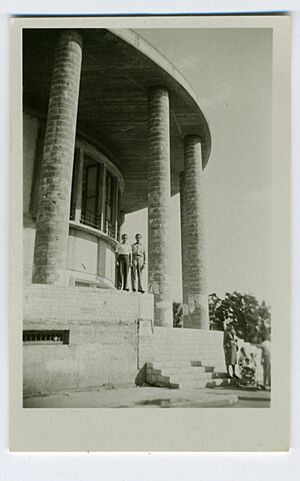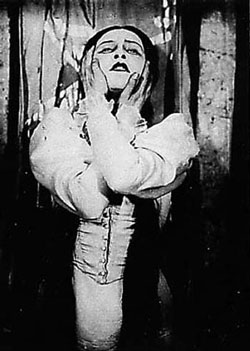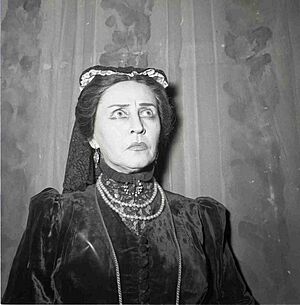Habima Theatre facts for kids
|
תיאטרון הבימה
|
|
 |
|
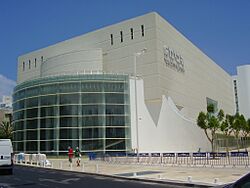
Habima Theatre in 2011, after its renovation.
|
|
| Address | Habima Square Tel Aviv Israel |
|---|---|
| Type | National theatre |
| Capacity | Rovina Theatre: 930 seats Meskin Theatre: 320 seats Bertonov Theatre: 220 seats Blanche Rapaport Theatre: 170 seats |
| Construction | |
| Opened | 1912 |
| Architect | Oskar Kaufmann, Eugene Stolzer |
| Website | |
| habima.co.il | |
The Habima Theatre (Hebrew: תיאטרון הבימה, which means The Stage Theatre) is the national theatre of Israel. It is also one of the world's first theatres to perform plays in the Hebrew language. You can find this famous theatre in Habima Square, right in the heart of Tel Aviv.
Contents
The Story of Habima Theatre
The Habima Theatre began its journey long ago and far from Israel. It has a rich history filled with challenges and triumphs.
Starting in Russia
Habima was started in 1912 by a man named Nahum Tsemakh in Białystok, which was then part of the Russian Empire. At first, it was a group of actors who performed for the love of theatre, not for money.
Because the group performed in Hebrew and told stories about Jewish culture, the Russian government banned them. This forced the actors to travel from place to place to perform.
Starting in 1918, the theatre got help from the famous Moscow Art Theatre. Famous directors like Konstantin Stanislavsky and Yevgeny Vakhtangov helped train the actors. Even Joseph Stalin, a powerful leader in the new Soviet government, gave his permission for the theatre to exist. However, some groups within the government saw the theatre as an enemy and tried to stop it from getting money.
Touring the World
In 1926, the Habima actors left the Soviet Union and went on a world tour. They performed in countries like Poland, Germany, France, and the United States. Their shows were a huge hit everywhere they went.
A year later, in 1927, the group split up. The founder, Nahum Tsemakh, and some actors decided to stay in the United States.
A New Home in Palestine
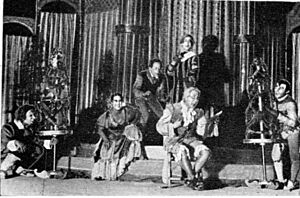
The rest of the actors brought the theatre company to Mandate Palestine (the land that would later become Israel) in 1928. They worked with a director from the Moscow Art Theatre to put on two new plays.
The first play was Ha-otsar (The Treasure), based on a story by the famous writer Sholem Aleichem. The second was Keter David (David's Crown), a play about a king from the Bible.
The company finally settled in Palestine for good in 1931. In 1945, they began building their own theatre building in Tel Aviv and started using it even before it was finished.
Becoming Israel's National Theatre
In 1958, Habima was officially named the national theatre of Israel. In that same year, the theatre won the Israel Prize, a very important award. It was the first time an organization, not just a person, received this prize.
Today, Habima is a busy and important cultural center. It has about 80 actors and 120 other staff members who help run the theatre.
A Modern Makeover
The theatre closed for four and a half years for major renovations and reopened in January 2012. An architect named Ram Karmi redesigned the historic building to make it modern and better than ever.
The project cost over 100 million shekels. The renovation added 500 square meters of space, including three new rooms for actors to practice. The four main auditoriums (the halls where audiences watch plays) were completely rebuilt. Each one has its own size and color:
- Rovina Hall is blue and can seat 930 people.
- Meskin Hall is lavender and seats 320 people.
- Bertonov Hall is green and has room for 220 people.
- Habima 4 Hall is decorated with wood and seats 170 people.
See also
 In Spanish: Teatro Nacional Habima para niños
In Spanish: Teatro Nacional Habima para niños
- List of Israel Prize recipients


